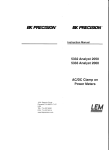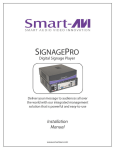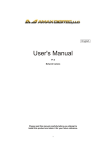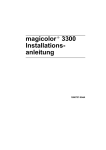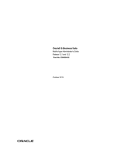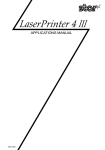Download ViewSonic CD-1010 Specifications
Transcript
CD-1010User’s Manual December 2009 Contents 1. Introduction 1 1.1. Hardware features 1 1.2. Software Features 1 1.3. Package Contents 2 1.4. Physical ports and features 2 1.5. VESA mounting kit (Optional Accessory) 2 2. Configuring the CD‐1010 Media Player 3 2.1. System Connections 3 2.2. USB keyboard Configuration Menus 3 2.3. Connect the CD‐1010 to your network 4 2.4. Clock and Calendar Settings 0 2.5. Brightness and Volume settings 5 2.6. Setting a password 6 2.7. Factory reset 6 2.8. Applying firmware upgrades 6 3. Content Management 7 4. Working with SMIL 8 4.1. Introduction 8 4.2. Playing a SMIL demo 8 4.3. www.a‐smil.org for Developers 8 5. Technical Data 9 5.1. Specifications 5.2. Mechanical Drawings 10 6. Appendix: FAQ 11 7. Appendix: Firmware Upgrades 13 7.1. 9 Firmware upgrade using Signage Manager Express 13 i 1. Introduction This document describes the hardware and software operations of the CD‐1010, system set up, and frequently asked questions. 1.1. Hardware features • • • • • • 10‐inch widescreen LCD displayand stereo speakers Built‐in wireless b/g network with optional USB Ethernet adapter Scala enabled for compatibility with Scala Content Manager Signage Manager Express configuration utility Content authoring via Microsoft PowerPoint (template‐based slide show creation) Supports advanced device programming via the W3C SMIL open API 1.2. Software Features Signage Manager Expressutility for streamlineddigital signage management Signage Manager Express helps you quickly set up and test playback on your digital signage player. Once you have scheduled your contents, you can quickly configureall players across the network simultaneously witha few clicks of the mouse. Please see the Signage Manager ExpressUser's Manual for operation details. Scala network enabled (Scala license required) Scala Enabled For industry leading network management, the CD‐1010Digital Signboard is certified to work in a Scala Content Manager networked environment.This provides you with maximum flexibility in a reliable, RISC‐based signage display. SMIL Open API for developers W3C SMIL The CD‐1010uses open XML‐basedscripting language for highly flexible content presentation and playback control, so that your investments are never obsolete. Using SMIL, the de facto language of multimedia communications, the player understands the language adopted by professional development tools from Adobe, Apple, Microsoft, Real Networks, and more. 1 1.3. Package Contents Main Unit AC Adapter Quick Start Guide Software CD NOT INCLUDED: A USB keyboard is required for system setup 1.4. Physical ports and features 1.5. VESA mounting kit(Optional Accessory) Part number IAD‐ACC‐ITM‐0020 The CD‐1010can be adapted for MIS‐D75 VESA mounting via the optional mounting kit. Please see the instructions sheet in the kit for installation details. 2 2. Configuring the CD‐1010Media Player 2.1. System Connections 1 Attach the AC power adapter to power on the unit.The following progress bar will be displayed on your monitor: ~ 90 seconds 2 Player boot process takes approximately 90 seconds to complete. After boot up, the player will indicate that it is ready for content sync via the USB port. The player will boot into the “Open Standard Media Player” screen. Plug in a USB keyboard to enter configuration menus. The menu and blue background will appear in about 30 seconds. If you have already loaded media contents into the player, contents will play back immediately after boot up, and the “Open Standard Media Player” screen will not be shown. You can still plug in a USB keyboard at any time during playback to enter the menu system. 2.2. USB keyboard Configuration Menus You must attach a USB keyboard to the CD‐1010to configure settings.With the player booted up and ready, it takes approximately 30 seconds after you plug in the keyboard for the following menu to be displayed: Navigating the menus Navigate the menus using arrow keys, space bar,enter key, ESC, and numeral keys on your USB keyboard. Use the keyboard arrow keys to highlight menu items, press the space bar to move the 3 star (cursor), and then press enter to confirm (<OK>) or reject (<Cancel>) any changes. 2.3. Connect the CD1010to your network Determine a connection type Wireless connection (built‐in): The player will scan for wireless signals nearby during boot up. If the network requires authentication, you will be asked to provide the password for access. (OPTIONAL) wired connection: Attach theUSB Ethernet Adapter accessory (sold separately) to your CD‐1010 media player’s USB port and connect a LAN cableto the adapter’s other end (RJ‐45 port).REBOOTplayer to initializethe adapter. Player IP address You will also need an IP address for the player on your network. This could be set automatically (DHCP) or manually (static IP): 1)DHCP – Automatically Assign Network IP Address DHCP is enabled by default. You do not need to change the settings unless setting a static IP. 2) Static – Manually Assign Network IP Address Highlight “IP configuration” and Move the highlight to “Static IP” press “Enter” on keyboard to below, press “Space bar” on the <Select> keyboard to fill in the star(*) at the Static IP brackets, and press “Enter” on the keyboard to select<OK>. Proceed to configure an available static IP address. Please ask your network administrator for assistance if necessary 4 2.4. Clock and Calendar Settings Highlight “Time setting” and press “Enter” on keyboard to <Select> You may skip “Set local time” as it will be synchronized automatically. SET the correct time zone. Daylight Saving (DST) rules can be configured when you enter theSet time zone submenu. 2.5. Brightness and Volume settings From the Main Menu, select Output setting to enter the submenu. You can enter the display brightness of the backlight in percentage (%) from 0 (dimmest) to 100 (brightest) You can enter the sound level in percentage (%) from 0(quietest) to 100 (loudest) or in decibels (db) from ‐22 (quietest) to 0 (loudest) 5 2.6. Setting a password The default password is blank. You may set a password to prevent unauthorized access to the player. You will have to reset the player if you forget the password. 2.7. Factory reset To re‐initialize the system, clear passwords, and return settings to their default values: 1. 2. 3. 4. 5. Power down the system (Power down button) Reconnect the power cord, then insert USB keyboard before the player fully boots up. Hold the Delete key on your keyboard to enter the reset menu Choose to reset password or restore all settings Confirm and wait while system reboot to complete reset. 2.8. Applying firmware upgrades Firmware updates can be performed using a USB flash drive or via network using Manager Express. Please read the release notes carefully regarding the changes that will be made to your player before applying the upgrade 1. 2. 3. 4. Obtain the latest firmware and copy it to the root directory of a USB drive Power on device and plug USB keyboard to the device to enter menu system Follow on screen instructions and select firmware upgrade option in the menu When instructed, plug in the USB drive to begin firmware upgrade 6 3. Content Management For testing videos and player connectivity, please see the SignageManager Express Software Manual for operating instructions. For setting up the player on a Scala Content Manager Network, please see theBridge Server 1.5 Quick Start Guide 7 4. Working with SMIL The CD‐1010uses open communications protocols for highly flexible content presentation and playback control. SMIL‐compliancemeans predictable results across multiple devices, and SMIL’s non‐ proprietary nature means that your investments are never obsolete. 4.1. Introduction Using SMIL (pronounced “smile”), the language created by W3C for multimedia communications, the media playerunderstands the language “spoken” by professional tools from companies such as Adobe, Apple, Microsoft, and Real Networks. What this means is quicker, easier, and better integration of your players into your digital signage networks, opening up avenues of software controls and realizing the full potential of your playerhardware down the road. 4.2. Playing a SMIL demo The demonstration files can be found in the Software and Documentation CD. Step 1: Prepare contents using a PC Prepare a formatted USB drive (using the “FAT32” file system option). Copy the entire sample SMIL directory with all its content files from Software and DocumentationCD to the USB drive. Make sure the SMIL directory shows up in the root directory of the USB drive. Step 2: Upload contents to player Power up the CD‐1010. Booting takes about 90 seconds. When the orange boot indicator lamp goes out, insert USB drive into the USB port to begin upload. All files under the SMIL directory will be copied to the player and the sample contents will begin to play. 4.3. www.asmil.org for Developers The media playerutilizes W3C SMIL open standard, making it easier to customize to your project management needs. For resources, downloads, and community support, please visit www.a‐smil.org. 8 5. Technical Data 5.1. Specifications Display and Sound Video format support Image format support Audio codec support Script language Software management Network Connectivity and I/O Ports Digital Signage Features Local storage CD‐1010 10.1” TFT LCD wide aspect ratio 800x480 native resolution Built‐in stereo speakers 1.5 Wx2 MPEG‐4 ASP/DivX (up to 720x480, 4Mbps) Recommended 16:9 video resolution: 640x360or 720x400 JPEG baseline (800x480recommended resolution) MP3 audio (up to 384Kbps), MPEG L2 audio (up to 384Kbps) W3C SMIL 3.0 (sub‐set):wall‐clock, sequential, parallel, and exclusive scheduling LAN – Manager Express USB direct update WAN – Optional Scala Content Manager network Wi‐Fi: IEEE 802.11 b/g Wi‐Fi Security: WPA/WPA2, TKIP/AES Ethernet: RJ45 Port via USB dongle (option) USB storage host (Type A) 3.5mm stereo audio out jack “Power auto on” upon power cord attach Automatic error recovery (built‐in WDT) Real‐time clock for playback scheduling Automatic NTP clock adjustment Power supply Internal 2GB NAND flash Memory expansion port: Compact Flash Card(CF) Type II, Secure Digital Card (SD andSDHC) Documentation CD Quick start guide AC power adapter Display stand VESA mounting kit (Optional) 5V, 2ADC Power consumption Typical* 5W Environmental Operating temperature: 0 – 40° C / 32 – 104° F Humidity: 5 – 85% @ 40° C / 32 – 104° F non‐condensing 271 x 185 x 29 mm 10.6” x 7.28” x 1.14” 680 grams 1.5 lbs. UL‐approved AC adapter CE/FCC RoHS One‐year limited parts & labor Accessories Dimensions(WxHxD) Weight Safety Certifications Warranty 9 5.2. Mechanical Drawings Units = mm 10 6. Appendix: FAQ What can I do to improve Signage Manager Express performance on my PC? The latest Microsoft .NET 3.5 SP1 offers improved performance and bug fixes to Signage Manager Express. You can install the update via this internet browser link http://go.microsoft.com/fwlink/?LinkId=124150 or by searching for “.NET 3.5 SP1” At www.microsoft.com. What is the maximum file size for a single video file? The maximum video file size for the CD‐1010is 2GB. We recommend reserving a safety margin to avoid exceeding the limit (i.e. limiting files to 1850MB). How do I manage the playback of contents? Playback on a schedule is one of the main functions of theCD‐1010. For most users, it can be managed via the easy to use Signage Manager Express software. Scala users may obtain a player license from Scala to manage the media player directly from Scala Content Manager. For advanced customization, there is SMIL compatibility. See the developer’s manual for customizing the player with open‐standard W3C SMIL commands. About Signage Manager Express: Unlike the difficulty of programming VCRs from a remote control, the Signage Manager Express software is designed to be simple by using a graphical personal computer interface. Playback contents are laid out visually in a calendar view. Anyone with basic computer skills can quickly create or modify schedules, delivering the right message to the right audience at the right times. Please refer to the Signage Manager Express User’s Manual for detailed operations and techniques. Could the player display Flash or Microsoft PowerPoint presentations? The player features limited PowerPoint support, but not Flash support. While PCs can play many formats with varying degrees of success, RISC‐based media players are designed to reliably play specific video formats (Please see spec for details). While Microsoft PowerPoint native files could not play directly on a RISC‐based player, the file is converted through other software (i.e. Signage Manager Express) into an image format to be played as an image slideshow. Why won’t some media files play smoothly? The video data bit‐rate may be higher than the recommended bit rate. The video data bit‐rate is the amount of video or audio data used per second to store or play the contents, usually expressed in Mbps (mega‐bits per second). Video encoded with excessive bit‐rates will not playback smoothly in the media player, likely due to storage i/o bottlenecks. You can tryrecompressing unplayable video files at lower bit rates using the free and open source Handbrake tool at http://handbrake.fr/. Once you have found the right output settings for size and quality, save them in Handbrake profiles for future use. Then you can easily recompress any unplayable files you encounter in the future. Why won’t some media files play at all? Despite our best efforts to adhere to video format standards, video compression introduces many variables, and sometimes the videos you acquire may not be playable on all players. In this case, you should check your compression settings (bitrate, audio codec, and other parameters) and use a compatible setting. If the files can play on your PC but not on your player, you should recompress the file to ensure playback. For greatest compatibility, we recommend outputting to the WMV format (VC‐1 codec, 3 to 5 Mbps bit‐rate). You can recompress unplayable video files with recommended file formats and bit rates using the free and open source Handbrake tool at http://handbrake.fr/. Once you have 11 found the right output settings for size and quality, save them in Handbrake profiles for future use. Then you can easily recompress any unplayable files you encounter in the future. The media playback looks different on a PC compared to the media player’s screen. (Wrong aspect ratio) There are 2 major aspect ratios (width‐to‐height ratios) for video content, but many kinds of displays. If you play 4:3 video on a 16:9 display (or vice versa), a circle becomes oval, and the picture takes on a squeezed or stretched look. To avoid this distorted look, adding black bars are a common technique. The Network Media Player can be configured to automatically add black bars for certain types of displays. You can set the output resolution in CD‐1010’s configuration menu to match the native resolution of your display. Some JPEG images cannot be playedinthe media player. Progressive JPEG are not supported. Please convert to baseline JPEG for maximum compatibility. JPEG images can be either of 2 types: baseline or progressive compression. Baseline JPEG offers greatest compatibility, while progressive JPEGs are suitable for web site images. Progressive images are downloaded and displayed “progressively,” being rendered more clearly as more data is received over the internet. Devices with local storage such as the CF/Network Media Player are usually incompatible with the latter type.Make sure to save images as baseline JPEG in your photo editor, or resave them as baseline JPEGs using free tools such as Paint.net (http://www.paint.net/). Does the media player support video streaming? No, all media files are designed to play from local storage (HDD or CF card). During content and schedule sync, contents are transferred to player’s local storage before being presented on screen. This ensures the best possible presentation and fluid delivery of your video message. Video streaming raises many playback quality issues such as image freezing, blocking, or blue‐screens, costing you valuable “air time” and losing your audience's attention. The media player is not playing. What should I do? Check the player’s messages on the display (OSD, or on screen display) for status information. Since RISC‐based media player usually lack input devices such as keyboard or mouse like PCs, troubleshooting is usually based on user’s knowledge and experience with the specific media player. First check the on screen message and stats reports. Bad play list and timing issues are two major causes of playback problems. To determine if the problem is caused by a bad play list, just delete the play list and restart player. The player should loop through all media files, indicating a fault with the play list. If the playback is scheduled to play at specific time, check to see if the device is set to the right time zone on the world clock. When nothing seems wrong, the time zone setting is often the reason the program is not played. 12 7. Appendix: Firmware Upgrades If you are using Signage Manager Express to manage existing media players, you may be prompted to upgrade the firmware to ensure to enable the latest scheduling features. Current versions of the firmware update files are included on the Signage Manager Express CD, while future upgrades may be obtained from your reseller. 7.1. Firmware upgrade using Signage Manager Express 1. 2. 3. 4. 5. Click “Firmware update” to enter the firmware update page Select your player model. If the model is not shown, then choose another applicable upgrade method to proceed. Select an upgrade method: Network, USB, or CF card (not all methods are applicable to all models). You can also manually select the location of a firmware obtained from your reseller. If you selected USB or CF card upgrade, you will need to specify the destination path of the drive or card. If you have set a password for the player, enter it in the Password field. Related instructions will be displayed on this page to help you complete the upgrade process. Finally, click on the Update device, Prepare CF card, or Prepare USB drive button to begin transfer of firmware. If the firmware source file cannot be found, you will be asked to locate the firmware manually. The firmware should be available on your Signage Manager Express CD or via your reseller. 13 LIMITED WARRANTY ® ViewSonic Limited Warranty Terms and Conditions How the Viewsonic Standard Limited Warranty works: ViewSonic Corporation (“ViewSonic”) warrants its products to be free from defects in material and workmanship during a specified length of time, or “Warranty Period”, as indicated below.If a product proves to be defective in material or workmanship during the Warranty Period, ViewSonic will, at its sole option, repair or replace the product with a similar product. Replacement products or parts may include remanufactured or refurbished parts or components. The replacement product will be covered by the balance of the time remaining on the customer's original ViewSonic Limited Warranty. This warranty does not cover any software included with the product. ViewSonic products are manufactured using new materials or new and used materials equivalent to new in performance and reliability. Spare parts may be new or equivalent to new. Spare parts are warranted to be free from defects in material or workmanship for the remainder of the Limited Warranty Period under proper and/or normal use of the ViewSonic Product in which they are installed. During the Limited Warranty Period, ViewSonic will, at its sole discretion, repair or replace the defective component parts or the ViewSonic product.All component parts or hardware products removed under this Limited Warranty become the property of ViewSonic. In the unlikely event that your ViewSonic Product has a recurring failure, ViewSonic will, at its sole discretion, provide you with a replacement unit of ViewSonic's choosing that is similar or equivalent to your ViewSonic originally purchased product in hardware and/or performance. How long the warranty is effective: ViewSonic warrants that its hardware will be free from defects in workmanship and materials, under proper normal use, and as set forth below: • • Hardware and Power Supplies: Three (3) Years Accessories, spare parts, and spare kits: Ninety (90) days The Warranty Period will begin on the date of purchase, and remain effective as specified above. Proof of purchase and/or receipt will be required for all claims purposes. Exclusions of Warranty: The following will immediately and automatically render any and all warranties and/or guarantees, including but not limited to the ViewSonic Limited Warranty, as void: 1. Any product on which the serial number has been defaced, modified or removed. 2. Accident, misuse, neglect, fire, water, lightning, or other acts of nature, unauthorized product modification, and/or failure to follow instructions as prescribed by ViewSonic. 3. Repair or attempted repair by someone other than a ViewSonic Licensed Technician. 4. Any damage resulting from shipments not made and/or insured by ViewSonic, and/or shipments made by ViewSonic for which recipient failed to notify ViewSonic of the damage claim within 48 hours upon receipt. 5. Removal and/or installation of any components not intended or prescribed by ViewSonic. 6. Causes external to the product, such as electric power fluctuations and/or failure. 7. Normal wear and tear. 8. Damage to, or abuse of, the coating on the surface of the display, including but not limited to cosmetic defects that do not affect functionality. 9. Any other cause which is not related to a manufacturer’s defect. 10. Loss of, or damage to, the covered product due to mishandling, improper packaging by you, alteration, accident, electrical current fluctuations or failure to follow operating, maintenance or environmental instructions prescribed in the covered product's User Manual.In the event that ViewSonic determines, in its sole discretion, that the return product is damaged due to one or more of these excluded causes, the customer will be billed for the cost of repairs. 11. ViewSonic will not be responsible for any damage to, loss of, or consequential loss from the inability to use, any programs, data or other information stored on any media or any part of any Product serviced hereunder. ViewSonic makes no representations or warranties whatsoever to keep confidential or secure any data stored on any media or any part of any Product serviced hereunder.ViewSonic will not be responsible for and hereby disclaims any and all liability for damage or loss to software, data, Programs, removable media, consumable, portable docking stations, carrying cases, or non‐ViewSonic‐branded products such as joysticks, printers, and/or scanners, that may occur as a result of repairs to, and/or by the replacement of any defective product.In order to avoid any and such losses or damages, please make a back‐up of any and/or all dates) and Programs before returning your product to ViewSonic for replacement and/or repair(s). 12. Image burn‐in and/or defective pixels/sub‐pixels are not considered a manufacturer’s defect. For a complete review of the details regarding 14 the industry standard methodology ViewSonic uses to determine defective pixels/ sub‐pixels please visit our on‐line Customer Support database at http://www.viewsonic.com/support/qa.cfm?topic=lcd&question=01. Limitation of Implied Warranties: THERE ARE NO WARRANTIES, EXPRESS OR IMPLIED, WHICH EXTEND BEYOND THE DESCRIPTION CONTAINED HEREIN INCLUDING THE IMPLIED WARRANTY OF MERCHANTABILITY AND FITNESS FOR A PARTICULAR PURPOSE. Limitations of Liability: VIEWSONIC'S LIABILITY IS LIMITED TO THE COST OF REPAIR OR REPLACEMENT OF THE PRODUCT. VIEWSONIC EXPRESSLY DISCLAIMS ANY AND ALL LIABILITY FOR DELAYS IN SHIPPING AND/OR ANY RESULTING DAMAGE(S) DUE TO LOSS OF USE FOR ANY AND ALL REASONS. IN NO EVENT WILL VIEWSONIC CORPORATION, AND ANY AND ALL OF ITS PRESENT, FORMER AND FUTURE REPRESENTATIVES BE LIABLE FOR SPECIAL INDIRECT, INCIDENTAL OR CONSEQUENTIAL DAMAGES RELATING DIRECTLY OR INDIRECTLY TO THIS AGREEMENT.FURTHER, VIEWSONIC WILL NOT BE LIABLE FOR LOSS OF THE USE OF PRODUCT, LOSS OF DATA, LOSS OF TIME, LOSS OF PROFITS, LOSS OF BUSINESS OPPORTUNITY, LOSS OF GOODWILL, INTERFERENCE WITH BUSINESS RELATIONSHIPS OR OTHER COMMERCIAL LOSS, REGARDLESS OF WHETHER ADVISE VIEWSONIC IS ADVISED OF OR SHOULD HAVE KNOWN ABOUT THE POSSIBILITY OF SUCH DAMAGES. How to get service: 1. For information on obtaining warranty service, call your ViewSonic dealer/reseller. 2. To obtain warranty service, please contact ViewSonic Customer Support for a Return Authorization number (RMA). You will be required to provide A. A copy of the dated sales slip. B. Your name. C. Your address. D. The serial number of the product. E. A description of the problem. F. Mobile and wireless products, customer should provide the user name and the password or disable password protections in order to allow ViewSonic access to the device for the performance of warranty service. 3.Bring or ship the product prepaid in the original container, with the associated accessories, to ViewSonic or any ViewSonic authorized service center. 4. For additional information or the name of the nearest ViewSonic service center, contact your ViewSonic dealer/ reseller or ViewSonic. NOTE: ViewSonic is not responsible for any returned product without an assigned RMA. Effect of state law: This warranty gives you specific legal rights, and you may also have other rights which vary from state to state. Some states do not allow limitations on implied warranties and/or do not allow the exclusion of incidental or consequential damages, so the above limitations and exclusions may not apply to you. 15

















